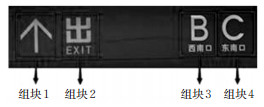Optimization of Guide Signs in Subways Based on Pedestrian Cognition Laws
-
摘要: 地铁引导标识担负着引导行人出行的重要功能, 目前许多引导标识设置混乱, 信息过载, 导致认知率较低。为了使行人更高效地从引导标识获取信息, 从行人认知规律出发, 分别针对行人的瞬时记忆、短时记忆遗忘规律设计了室内认知试验, 通过对引导标识信息进行组块划分, 对不同组块数量标识的瞬时记忆容量进行研究; 采用“Brown-Peterson”法对短时记忆中信息的遗忘规律进行探究。研究结果表明: 行人3 s瞬时记忆量在4±1个信息块; 行人在没有复述的情况下, 信息记忆可以保持15~20 s。在西安市地铁2/3号线的换乘站小寨站进行行人跟踪试验, 观察行人行为特征, 分析引导标识设置存在的问题。观察结果与室内认知试验研究一致, 验证了室内认知试验的科学性。Abstract: Guide signs in subways play an important role in guiding pedestrians during their travel. Many guides are disorderly set up and overloaded with information, resulting in a low cognitive rate. This paper takes pedestrian cognition laws as a starting point and designs indoor cognitive experiments for the forgetting laws of immediate memory and short-term memory of pedestrians to enable pedestrians to obtain information from guide signs more efficiently. The instantaneous memory capacity of identifying different block numbers is studied by dividing the guide identification information into blocks. Brown-Peterson method is used to study the information forgetting law in short-term memory.The results show that the immediate memory of pedestrians in 3 seconds is 4±1 information chunk, and pedestrians can keep information memory for 15-20 s without retelling. By the tracking test of pedestrians at the transfer station of Xi'an Metro Line 2 and Line 3 at Xiaozhai Station, the characteristics of pedestrians' behaviors are observed, with problems existing in the setting of guide signs analyzed. The results are consistent with indoor cognitive experiments, which verify the experiments.
-
Key words:
- rail transit /
- guidance signs in subways /
- design research /
- cognitive experiment /
- immediate memory /
- forgetting law
-
表 1 不同组块标识
Table 1. Different chunked signs

表 2 不同组块标识瞬时记忆
Table 2. Immediate memory for different chunk numbers on guide signs
标识类型 记忆量均值/组块 记忆准确率/% 3组块 1.81 60.33 4组块 2.73 68.25 5组块 2.65 53.00 6组块 3.03 50.50 8组块 3.34 41.75 12组块 3.77 31.42 表 3 不同性别行人短时记忆的标识信息量准确率
Table 3. Accuracy rate of the short-term memory for samples with different genders
性别 不同记忆时间间隔(s)行人短时记忆准确率/% 5 10 20 40 60 男 84.25 80.26 71.05 66.67 63.60 女 82.08 78.30 68.88 66.04 62.26 表 4 测试者各时间节点的引导信息记忆量
Table 4. Memory capacitance of guide information at each time node of test subjects
时间/s 各时间节点引导信息记忆量/% 5 83.25 10 79.32 20 70.00 40 66.37 60 63.00 表 5 行人停留数据
Table 5. Stopping data of pedestrians
停留点位 停留次数 标识组块数 1 6 4 2 17 7 3 22 10 4 11 8 5 42 12 6 4 5 7 1 5 8 18 8 9 23 8 10 9 5 -
[1] 宋波, 陈芳, 苏经宇. 地铁应急疏散标识系统优化[J]. 北京工业大学学报, 2008, 34(5): 504-510. https://www.cnki.com.cn/Article/CJFDTOTAL-BJGD200805013.htmSONG Bo, CHEN Fang, SU Jingyu. Optimization of subway emergency evacuation sign system[J]. Journal of Beijing University of Technology, 2008, 34(5): 504-510. (in Chinese) https://www.cnki.com.cn/Article/CJFDTOTAL-BJGD200805013.htm [2] ICHIRO W. Standardized guide signs at Yokohama station[J]. Japanese Railway Engineering, 2005(45): 16-18. http://trid.trb.org/view/765881 [3] FILIPPIDIS L, GALEA E R, GWYNNE S, et al. Representing the influence of signage on evacuation behavior within an evacuation model[J]. Journal of Fire Protection Engineering, 2006, 16(1): 37-73. doi: 10.1177/1042391506054298 [4] 韩艳欣, 张喜. 基于遗传算法的车站标识决策点布设方法研究[J]. 铁路计算机应用, 2009, 18(11): 10-13. doi: 10.3969/j.issn.1005-8451.2009.11.004HAN Yanxin, ZHANG Xi. Research on optimization method for decision making point of guide sign in passenger station based on GA[J]. Railway Computer Application, 2009, 18(11): 10-13. (in Chinese) doi: 10.3969/j.issn.1005-8451.2009.11.004 [5] 穆瑞杰. 基于遗传算法的地铁车站引导标识布点探析[J]. 郑州大学学报(工学版), 2018, 39(1): 73-77. https://www.cnki.com.cn/Article/CJFDTOTAL-ZZGY201801013.htmMU Ruijie. Analysis on the layout of subway station guidance signs based on genetic algo-rithm[J]. Journal of Zhengzhou University(Engineering Science Edition), 2018, 39(1): 73-77. (in Chinese) https://www.cnki.com.cn/Article/CJFDTOTAL-ZZGY201801013.htm [6] KONG Jian, SHU Yu, MA Shi, et al. Comprehensive evaluation research on efficacy of service sign system of subway station[J]. Journal of Tongji University, 2007, 35(8): 1064-1068. http://www.researchgate.net/publication/286606067_Comprehensive_evaluation_research_on_efficacy_of_service_sign_system_of_subway_station [7] NASSAR K. Sign visibility for pedestrians assessed with Agent-based simulation[J]. Transportation Research Record, 2011, 2264(1): 18-26. doi: 10.3141/2264-03 [8] VILAR E, REBELO F, NORIEGA P, et al. Effects of competing environmental variables and signage on route-choices in simulated everyday and emergency wayfinding situations[J]. Ergonomics, 2014, 57(4): 511. doi: 10.1080/00140139.2014.895054 [9] WANG W L, LO S M, LIU S B, et al. Microscopic modeling of pedestrian movement behavior: Interacting with visual attractors in the environment[J]. Transportation Research Part C: Emerging Technologies, 2014(44): 21-33. http://www.onacademic.com/detail/journal_1000036091868410_e918.html [10] 张蜇, 贾利民, 秦勇. 基于协同引导的地铁站台导向标识系统布局优化[J]. 交通运输系统工程与信息, 2016, 16(4): 146-152. doi: 10.3969/j.issn.1009-6744.2016.04.021ZHANG Zhen, JIA Limin, QIN Yong. Optimization of signage system configuration on metro platform based on cooperative guidance[J]. Journal of Transportation Systems Engineering and Information Technology, 2016, 16(4): 146-152. (in Chinese) doi: 10.3969/j.issn.1009-6744.2016.04.021 [11] 原志路. 基于改进社会力模型的行人流疏散仿真研究[D]. 长春: 吉林大学, 2017.YUAN Zhilu. Research on simulation of pedestrian flow evacuation based on improved social force model[D]. Changchun: Jilin University, 2017. (in Chinese) [12] LEI Bin, XU Jinliang, LI Menghui, et al. Enhancing role of guiding signs setting in metro stations with incorporation of microscopic behavior of pedestrians[J]. Sustainability, 2019, 11(21): 6109. doi: 10.3390/su11216109 [13] 林雨, 潘晓东, 方守恩. 指路标志信息量与认知性关系研究[J]. 交通运输工程与信息学报, 2005(3): 73-77. doi: 10.3969/j.issn.1672-4747.2005.03.011LIN Yu, PAN Xiaodong, FANG Shouen. Relationship between information quantum of traffic guide sign and its cognition[J]. Journal of Transportation Engineering and Information, 2005(3): 73-77. (in Chinese) doi: 10.3969/j.issn.1672-4747.2005.03.011 [14] SANTIAGO O B, LOUISE V. Urban signs. The relationship between signage and road accidents[J]. Design Journal, 2019, 22(1): 2163-2164. [15] LI Zhihong, XU Wangtu (Ato). Path decision modelling for passengers in the urban rail transit hub under the guidance of traffic signs[J]. Journal of Ambient Intelligence and Humanized Computing, 2019, 10(1): 365-372. doi: 10.1007/s12652-017-0544-y [16] 王甦, 汪安圣. 认知心理学[M]. 重排本. 北京: 北京大学出版社, 2010.WANG Su, WANG Ansheng. Introduction to cognitive psychology[M](Rearrangement). Beijing: Peking University Press, 2010. (in Chinese) [17] INTONS-PETERSON M J, ROCCHI P, WEST T, et al. Age, testing at preferred or nonpreferred times(testing optimality), and false memory[J]. Journal of Experimental Psychology: Learning, Memory, and Cognition, 1999, 25(1): 23-40. doi: 10.1037/0278-7393.25.1.23 [18] MILLER G A. The magical number seven plus or minus two: Some limits on our capacity for processing information[J]. Psychological Review, 1956, 63(2): 81-87. doi: 10.1037/h0043158 [19] COWAN N. The magical mystery four: How is working memory capacity limited, and why?[J]. Current Directions in Psychological Science, 2010, 19(1): 51-57. doi: 10.1177/0963721409359277 [20] ATKINSON R C, SHIFFRIN R M. Human memory: A proposed system and its control processes[J]. Psychology of Learning and Motivation, 1968(2): 89-195. [21] EBBINGHAUS H. A supposed law of memory[J]. Mind, 1886, 11(42): 300. [22] 刘星星. 基于驾驶人短时记忆及其衰减特性的城市交叉口指路标志安全设计方法[D]. 西安: 长安大学, 2017.LIU Xingxing. The safety designing methods of the intersection guide sign in city based on drivers'short-term memory and its attenuation characteristics[D]. Xi'an: Chang'an University, 2017. (in Chinese) -





 下载:
下载:













